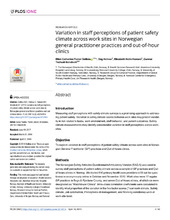| dc.contributor.author | Deilkås, Ellen C Tveter | en_US |
| dc.contributor.author | Hofoss, Dag | en_US |
| dc.contributor.author | Hansen, Elisabeth Holm | en_US |
| dc.contributor.author | Bondevik, Gunnar Tschudi | en_US |
| dc.date.accessioned | 2019-11-27T15:18:32Z | |
| dc.date.available | 2019-11-27T15:18:32Z | |
| dc.date.issued | 2019-04-10 | |
| dc.Published | Deilkås ETD, Hofoss D, Hansen E, Bondevik GT. Variation in staff perceptions of patient safety climate across work sites in Norwegian general practitioner practices and out-of-hour clinics. PLOS ONE. 2019;14(4)): e0214914 | eng |
| dc.identifier.issn | 1932-6203 | |
| dc.identifier.uri | https://hdl.handle.net/1956/21035 | |
| dc.description.abstract | Introduction Measuring staff perceptions with safety climate surveys is a promising approach to addressing patient safety. Variation in safety climate scores between work sites may predict variability in risk related to tasks, work environment, staff behavior, and patient outcomes. Safety climate measurements may identify considerable variation in staff perceptions across work sites. Objective To explore variation in staff perceptions of patient safety climate across work sites in Norwegian General Practitioner (GP) practices and Out-of-hours clinics. Methods The Norwegian Safety Attitudes QuestionnaireAmbulatory Version (SAQ A) was used to survey staff perceptions of patient safety climate across a sample of GP practices and Outof- hours clinics in Norway. We invited 510 primary health care providers to fill out the questionnaire anonymously online in October and November 2012. Work sites were 17 regular GP practices in Sogn & Fjordane County, and seven Out-of-hours clinics, of which six were designated as “Watchtower Clinics”. Intra–class correlation coefficients were calculated to identify what proportion of the variation in the five factor scores (Teamwork climate, Safety climate, Job satisfaction, Perceptions of management, and Working conditions) were at work site-level.Results Of the 510 invited health care providers, 266 (52%) answered the questionnaire. Staff perceptions varied considerably at the work site level: intra–class correlation coefficients (ICCs) were 12.3% or higher for all factors except for Job satisfaction–the highest ICC value was for Perceptions of management: 15.5%. Conclusion Although most of the score variation was at the individual level, there was considerable response clustering within the GP practices and OOH clinics. This implies that the Norwegian SAQ A is able to identify GP practices and OOH clinics with high and low patient safety climate scores. Patient safety climate scores produced by the Norwegian version of the SAQ A may, thus, guide improvement and learning efforts to work sites according to the level of their scores. | en_US |
| dc.language.iso | eng | eng |
| dc.publisher | PLOS Public Library of Science | eng |
| dc.rights | Attribution CC BY | eng |
| dc.rights.uri | http://creativecommons.org/licenses/by/4.0/ | eng |
| dc.title | Variation in staff perceptions of patient safety climate across work sites in Norwegian general practitioner practices and out-of-hour clinics | en_US |
| dc.type | Peer reviewed | |
| dc.type | Journal article | |
| dc.date.updated | 2019-10-11T07:43:55Z | |
| dc.description.version | publishedVersion | en_US |
| dc.rights.holder | Copyright 2019 The Authors | |
| dc.identifier.doi | https://doi.org/10.1371/journal.pone.0214914 | |
| dc.identifier.cristin | 1708497 | |
| dc.source.journal | PLoS ONE | |

